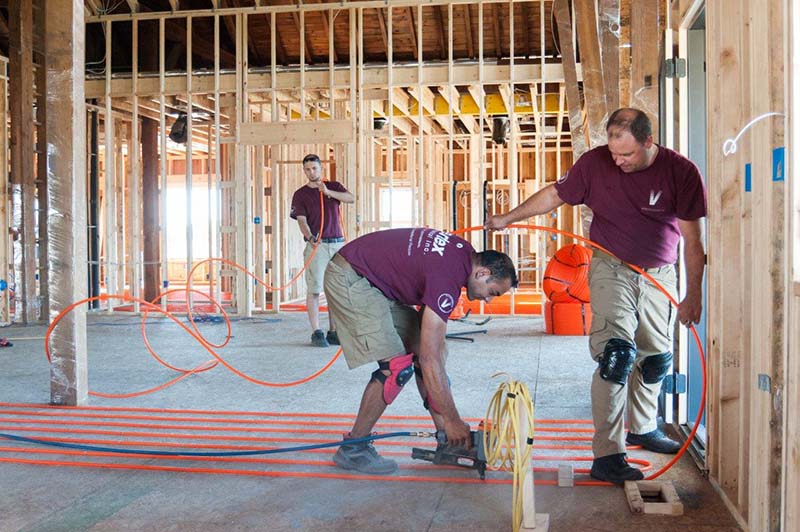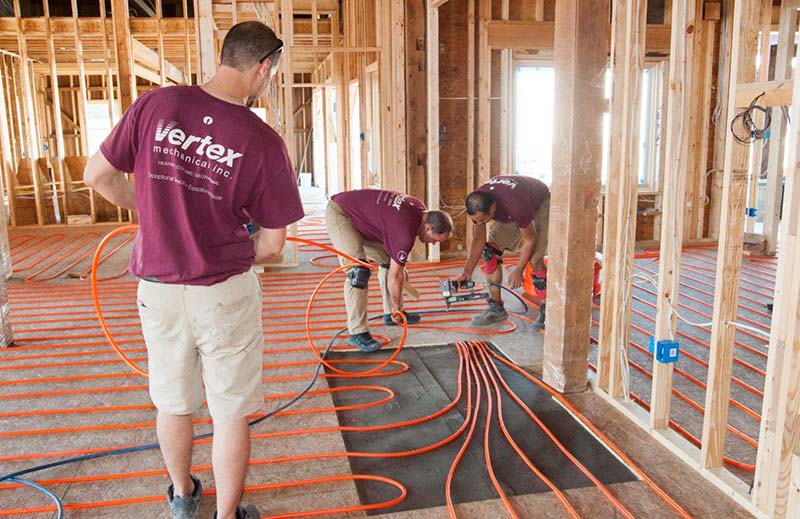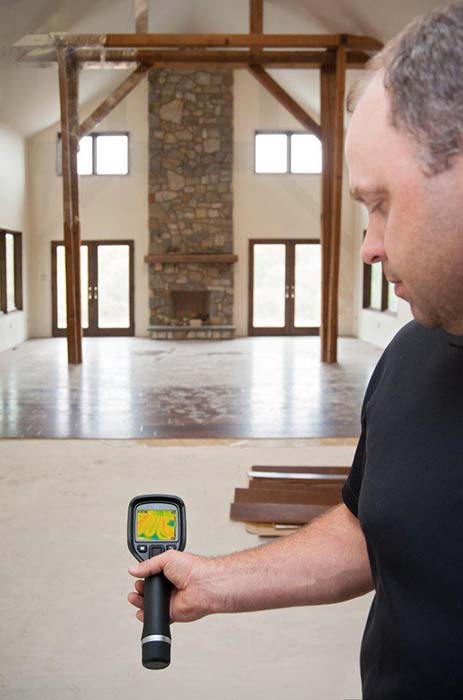Years ago, I had a high school science teacher ask our class the following question: If a piece of wood and a steel rod sat outside on a 20-degree day, which one would be warmer? While the class pondered the inscrutable question, I sat wondering, “What’s the catch?”
There’s always a catch. Kind of like asking who is buried in Grant’s tomb. The answer was in the question.
In a class of eager 17-year-olds, there were those who raced to be first, agreeing with others that the steel rod was colder. Of course, the answer to that question is the same now as it was then — both objects are, in fact, the same temperature.
The question wasn’t which one was warmer, but which one felt warmer. Since they were both outside in the same conditions, they had to be the same temperature. But steel would feel colder because steel is more conductive; that is, it moves energy away from our hands faster than wood does.
In the world of radiant floor heating, I’ve found a similar misconception when discussing the differences between pipe options used in a radiant floor installation. Specifically, questions arise about whether PEX is more efficient than EPDM. Since PEX uses a lower fluid temperature, some might say the system with PEX distribution is more efficient. But is one pipe option really more efficient?
To answer this, we need to understand how heat is transferred in, and through, a radiant floor. Believe it or not, not all heat is created or distributed equally. There are three methods of heating: convection, conduction, and radiant.
Convective systems rely on a medium — generally air — to be moved from one location to another by some mechanical means, usually a fan. In a hydronic system, the air is replaced with water and the fan is replaced with a circulator. Water moves heat energy from the boiler out to the radiant zone. Many of you know this, but I’ve got to state it anyway: Water is several times more conductive than air and many times more capable of moving energy than air.
Conductive transfer is when two objects of different temperature come in contact. The warmer object will impart heat energy to the cooler object via the area of contact. Think about your hand on that steel pole mentioned earlier. The pole, being more conductive, allows the heat to leave your hand quickly, causing you to feel colder. In a radiant system, conduction takes place anywhere the radiant tubing is in contact with a flooring material, or subfloor — or in some cases, with the help of a heat transfer plate.
Radiant transfer is when a warmer object emits energy to a colder object via energy waves. A good example of this is a heat lamp hanging over a basket of fries at the local drive-through. The hotter lamp keeps the fresh fries hot. With radiant heat, the key phrase to remember is that heat moves from hot to cold.
Teamwork and Radiant Floor Systems
All three methods — teamwork, if you like sports analogies — go into making a radiant floor system work. To help illustrate the mechanics of heat transfer, let’s walk through the following example: A typical 20 x 20 foot room has a heating intensity of 25 Btuh/square foot and a desired room temperature of 70°F. Our calculations show the room will not meet our design heat load if the floor surface temperature is below 80°F.

The floor in this case is a radiant panel, and it is transferring energy into the room because it has an elevated temperature of 80°F (remember, hot moves to cold). Does it matter what the floor covering is? No, not from the room’s perspective. All the room cares about is having a surface that is the right temperature. Does the floor covering affect the room’s heat loss? No again. The room’s heat loss is dictated by the overall construction: wall R-value, window area, exposed wall length, etc. In this case the room is going to have a 25 Btuh/square foot load and must have an 80°F floor surface temperature regardless of the floor covering.
The same applies for floor construction. We can have a slab, thin slab, or a frame floor and the same requirements hold true: The floor surface temperature needs to be 80°F in order to satisfy the heat loss of 25 Btuh/square foot.
Now, that isn’t to say floor construction or floor coverings aren’t important — they are. Floor construction will dictate the path (direction of least thermal resistance) the energy will take from the radiant tubing to the floor surface and will impact overall response time. The more mass (i.e., slab), the longer a system will take to respond in changing conditions. But, for our example, let’s keep everything the same and only focus on changes in tubing.
The Floor’s Role in Radiant Heating
Floor coverings are part of the floor construction and thus part of the overall floor R-value. Changing floor coverings will impact fluid temperatures. More conductive coverings will allow for lower fluid temperatures while maintaining the same surface temperature.

Remember, heat moves to cold in a very predictable manner. The greater the temperature change (delta T, or ∆T), the greater the energy movement through a given material. Having a more restrictive floor covering or construction mandates more energy. Or, rather, the higher the material resistance, the greater the ∆T needs to be to transfer the same amount of energy through the material.
If we change our floor covering in our example room from carpet to tile, the required energy is still the same — 25 Btuh/square foot — and the surface temperature still needs to be 80°F. Even though the design conditions are the same, the construction is not. Since we changed the floor covering to tile, the overall material resistance went down, increasing the overall conductivity value of the floor.
We still need an 80°F floor surface temperature, but we can now achieve the require heating intensity with a smaller ∆T (a lower supply fluid temperature) between the 80°F floor surface and the tubing, assuming the rest of the floor construction remains the same.

So, what happens to our design if we change tubing options? To better understand this change, we need to dive into the mechanics of what’s happening between the fluid inside the tubing and the floor.
We need to identify efficiency — the ratio of useable energy to total energy provided. This total energy includes not only the energy provided to the room but also energy lost to miscellaneous sources, called back and edge losses (the area below and to the side of our radiant panel).
We’ve already concluded that the room’s heating intensity is the same since the load is dictated by the room construction, not the floor. What affects efficiency now is the back and edge loss, which is directly impacted by the surface temperature, or skin temperature, of the radiant piping. The higher the skin temperature, the higher the back and edge loss. If the skin temperature is the same, then the back and edge losses are the same.
There are several tubing options on the market today, and each one will call for a slightly different design condition based on the given heating application. Our example room calls for a 25 Btuh/square foot load and an 80°F floor surface temperature requirement. The first thing we need to do is to determine the required skin temperature to properly heat this room. From there we can determine the necessary fluid temperature and then finally the overall panel efficiency.
To determine the required skin temperature, we need to work from the floor covering back to the tubing. In our example room, the required floor surface temperature is 80°F. Considering the floor construction has a known conductivity value, the embedded radiant piping will have a fixed skin temperature. This is the same skin temperature needed to maintain the required floor surface temperature regardless of the piping option used.
So, systems using an EPDM tubing would need the same skin temperature as a system using PEX or PE-RT. If the skin temperature was different, then the resulting floor surface temperature would be different.
However, equal skin temperatures do not mean equal supply fluid temperatures. The reason why is directly related to the ∆T through the tubing wall, the conductivity value of the pipe material, and to some degree the diameter of the pipe used. Figure 1 shows various characteristics of four pipes used in a typical radiant floor heating system. Copper is shown as a control reference.
| Tubing Material | Inside Diameter | Outside Diameter | Thermal Conductance | Thermal Resistance |
| (inch) | (inch) | (Btu/hr.*ft.*°F) | (hr.*ft.*°F/Btu) | |
| 1/2" EPDM | 0.5 | 0.875 | 0.17 | 0.5239 |
| 1/2" PEX-AL-PEX | 0.472 | 0.63 | 0.26 | 0.1767 |
| 1/2" PEX or PE-RT | 0.472 | 0.63 | 0.237 | 0.1939 |
| 1/2" L Copper | 0.545 | 0.625 | 223 | 0.9775 x 10-4 |
Figure 1
Piping thermal resistance values are calculated using the equations found in Chapter 6: Panel Heating and Cooling, 2000 ASHRAE Handbook-HVAC Systems and Equipments. Once the equivalent tubing conductivity value is calculated, a corresponding temperature drop through the tubing wall can be determined.
| Tubing Material | Temperature Drop |
| (tw - td) °F | |
| 1/2" EPDM Rubber | 13.098 |
| 1/2" PEX-AL-PEX | 4.418 |
| 1/2" PEX or PE-RT | 4.848 |
| 1/2" L Copper | practically 0°F |
Figure 2
EPDM tubing will require a higher supply temperature because it has a slightly higher material thermal resistance and wall thickness. When compared to PEX, EPDM will require approximately 8.68°F (13.0980 – 4.418 = 8.68) higher fluid temperature than PEX in the same application.
A fixed ∆T between the skin temperature and the floor prevents the system from delivering more, or less, energy than needed. A problem here would result in the room overheating or under heating. The system needs to have the same skin temperature whether we use EPDM, PEX, or PE-RT. Same surface temperature indicates the same back and edge loss, meaning the panel efficiencies remain the same, even though the supply fluid temperature varies.
The bottom line: It’s important to design a radiant system for the components being used and, more importantly, installed according to the specified design.
So, like the question involving the piece of wood and steel rod asked by my high school science teacher, what is the answer to “Which pipe is warmer in a radiant floor?” The answer — all piping is the same temperature.



Report Abusive Comment